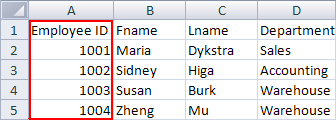If you plan to update your drawing as the data in your data source changes, make sure that each row of your data source has a unique identifier (a key column) that won't change. That key allows each row in the updated data to be accurately matched to a row in the data source you are updating from.
In the following example of an Excel worksheet, the unique identifier, or key, is the EmployeeID column.

Rows in my data are uniquely identified by the value(s) in the following column(s) The wizard suggests a key column to use but you can choose a different one if you like. If there is a combination of columns that uniquely identifies each row, select the check box next to each name. For example, there may be two employees with the first name Chris and two employees with the last name Lee, but no two employees have the same first and last names. So you could use a combination of the First name column and the Last name column to uniquely identify each row. This could be called a compound key.
Rows in my data do not have a unique identifier. Use the order of the rows to identify changes. This option is best if you don't have a column that uniquely identifies each row and you don't expect significant changes to your data source, such as adding or deleting rows.










